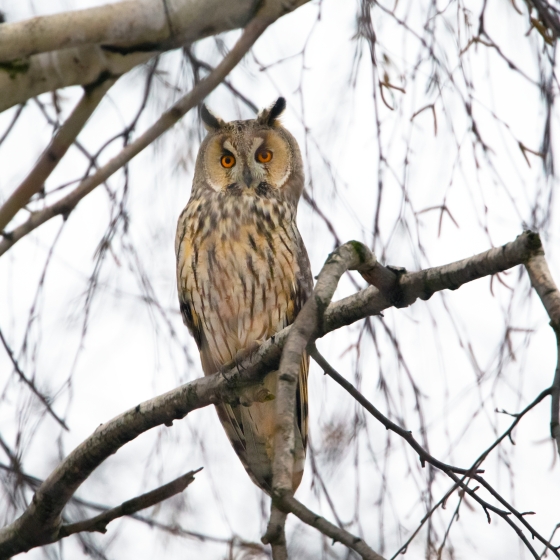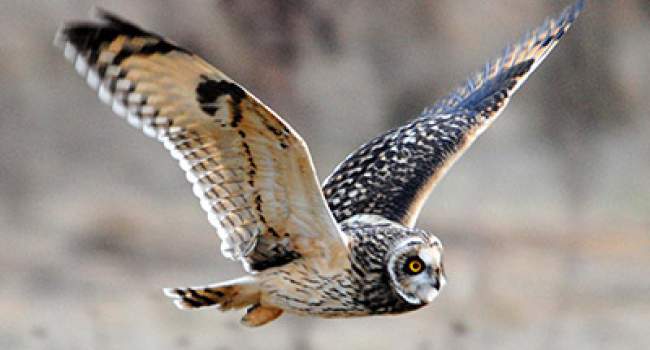Long-eared Owl
Asio otus (Linnaeus, 1758)
LE
 LOEOW
LOEOW  7670
7670

Family: Strigiformes > Strigidae

The Long-eared Owl is perhaps our most secretive owl. Almost entirely nocturnal in its habits it is a very difficult bird to census.
Its bright orange eyes, long ‘ear tufts’ and chestnut plumage ensure that any sighting of a Long-eared Owl is a treasured one. A denizen of deep woodland and scrubby shelterbelts, the Long-eared Owl is more often heard than seen. The best time to assess numbers, or even the presence of Long-eared Owls, is during the summer months when the ‘squeaky gate’ call of the young can be heard.
During harsh winters on the Continent our resident birds may be joined by migrant Long-eared Owls escaping the cold conditions. At this time of the year individuals may congregate in communal winter roosts, though the numbers of winter immigrants has decreased over recent years.
Identification
Long-eared Owl identification is often straightforward. The following article may help when identifying Long-eared Owl.
SONGS AND CALLS
Listen to example recordings of the main vocalisations of Long-eared Owl, provided by xeno-canto contributors.
Begging call
Call
Song
Song
Develop your bird ID skills with our training courses
Our interactive online courses are a great way to develop your bird identification skills, whether you're new to the hobby or a competent birder looking to hone your abilities.
Browse training coursesStatus and Trends
Population size and trends and patterns of distribution based on BTO surveys and atlases with data collected by BTO volunteers.
CONSERVATION STATUS
This species can be found on the following statutory and conservation listings and schedules.
POPULATION CHANGE
The Long-eared Owl is a scarce species in the UK and is monitored by the RBBP; however as a nocturnal species which is difficult to detect it is substantially under-reported and the trend is uncertain (Eaton et al. 2021). The most recent UK population estimate is 1,800+ pairs (APEP4) but this is also highly uncertain. The number of occupied 10-km squares in Britain has declined by 18% since the 1968–72 Breeding Atlas, but the map shows many gains and losses which may suggest difficulties in detecting the species when present (Balmer et al. 2013).
DISTRIBUTION
Long-eared Owls breed at scattered locations in Britain and throughout Ireland. In Ireland the Long-eared Owl is the most abundant owl species, and probably benefits from the absence of the competitively dominant Tawny Owl. Long-eared Owls are sedentary throughout Britain & Ireland but are joined by annually variable numbers of autumn immigrants from Fennoscandia. The winter distribution is patchy throughout both Britain and Ireland and likely to suffer from under-recording.
Occupied 10-km squares in UK
| No. occupied in breeding season | 566 |
| % occupied in breeding season | 19 |
| No. occupied in winter | 471 |
| % occupied in winter | 16 |
European Distribution Map
DISTRIBUTION CHANGE
The Long-eared Owl's breeding range has apparently contracted by 18% since the 1968–72 Breeding Atlas but there is also marked turnover, with more than half of squares showing gains or losses since 1968–72. This may be partly a consequence of birds being missed in one atlas or another, but the significant gains in northern England and clusters of losses in southeast England, southwest Scotland and the Black Isle are notable.
Change in occupied 10-km squares in the UK
| % change in range in breeding season (1968–72 to 2008–11) | -19.8% |
| % change in range in winter (1981–84 to 2007–11) | +47.7% |
SEASONALITY
Long-eared Owls are present throughout the year but not often recorded on daytime lists. Reporting is slightly higher in summer when juveniles are easily detected by their squeaky calls.

Movement
Information about movement and migration based on online bird portals (e.g. BirdTrack), Ringing schemes and tracking studies.
RINGING RECOVERIES
View a summary of recoveries in the Online Ringing Report.
Foreign locations of birds ringed or recovered in Britain & Ireland

Biology
Lifecycle and body size information about Long-eared Owl, including statistics on nesting, eggs and lifespan based on BTO ringing and nest recording data.
PRODUCTIVITY & NESTING
SURVIVAL & LONGEVITY
View number ringed each year in the Online Ringing Report
Maximum Age from Ringing 
|
12 years 10 months 12 days (set in 1987) 
|
Typical Lifespan 
|
4 years with breeding typically at 1 year |
Adult Survival 
|
0.69  
|
Juvenile Survival 
|
0.48 (in first year) 
|
BIOMETRICS
Wing Length 
|
Adults | 298.9±7.6 | Range 287–312mm, N=138 |
| Juveniles | 298.5±12.1 | Range 274-312mm, N=52 | |
| Males | 296.1±7.1 | Range 285–312mm, N=35 | |
| Females | 300.2±7.6 | Range 288–312mm, N=81 |
Body Weight 
|
Adults | 289±39.54 | Range 215–347g, N=125 |
| Juveniles | 281±31.3504 | Range 223–333g, N=39 | |
| Males | 266±41.69 | Range 186–329g, N=33 | |
| Females | 300±35.08 | Range 245–365g, N=76 |
Feather measurements and photos on featherbase 
CODES & CLASSIFICATION
Ring size 
|
G* or F* |
Field Codes 
|
2-letter: LE | 5-letter code: LOEOW | Euring: 7670 |
For information in another language (where available) click on a linked name
Research
Interpretation and scientific publications about Long-eared Owl from BTO scientists.
CAUSES AND SOLUTIONS
Causes of change
Due to the difficulties in detecting the species the trend is uncertain and hence the drivers of change are also unclear.
Links to more information from ConservationEvidence.com
Would you like to search for another species?












Share this page